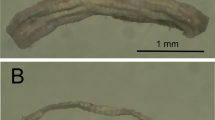Summary
A quantitative histochemical analysis of almost 200 mouse triceps surae muscle fibres is presented, together with some data from similar surveys of rabbit skeletal muscles. In the main work, ten parameters are considered: mean diameter, and reaction intensities (estimated as apparent absorbances) of three markers for oxidative-lipolytic metabolism, three for metabolism associated with glycolysis and three for the type of myosin. Cytoarchitecture of one deposit (succinate dehydrogenase) is also noted.
Frequency histograms for each parameter and correlation analyses for all possible pairings demonstrate that markers within the same metabolic system are not truly equivalent. Therefore, fibre typing in terms of just one marker from each system cannot be independent of the markers used. Selecting the most sharply discriminatory pair-myosin ATPase (following formalin and alkaline pretreatment) and glycogen phosphorylasea — one isolates four more-or-less discrete clusters of points. Taking succinate dehydrogenase also into account, to indicate characteristic oxidative levels within clusters, one can label the indicated ‘fibre types’ (following a well-established muscle terminology) as ‘fast, essentially glycolytic’ (FG), ‘fast, oxidative and glycolytic’ (FOG), ‘fast, essentially-oxidative’ (FO) and ‘slow, essentially oxidative’ (SO). However, with either α-glycerophosphate dehydrogenase or the periodic acid-Schiff reaction (PAS) as glycolytic marker, the FO-group is not separated from the FOG; and with oxidative level as a primary clustering criterion FG and FOG groups are continuous. An entirely different basis for classification-cytoarchitecture-also suggests four fibre types but the divisions most comparable to the FG/FOG and FOG/FO boundaries are best located somewhat differently again.
Some of the techniques of formal cluster analysis are next introduced. These are ways of searching for similarities (defined in terms of various objective criteria) in large volumes of essentially multivariate data.
Within a sample, considered representative of acceptably artefact-free fibres, virtually the same four groups as before are identified. The only difference is that what were earlier grouped as the ‘most oxidative FG’ fibres are now classed FOG; the acid-pretreated myosin ATPase reaction (previously little considered) contributes to this reclassification. At the five cluster level, a strong tendency exists for this small group, designated FG(O), to appear separately. At the two-cluster level classical distinctions in terms of high/low oxidative capacity, glycolytic capacity and myosin ATPase activity are each favoured by different similarity criteria.
Surveying the whole sample of fibres, only criteria which favour non-rambling clusters produce similar results to those above. However, an artefact in one reaction, for which there is strong internal evidence, is able to explain almost all other effects. These results do not prove the biological ‘rightness’ of a 4–5 cluster pattern, but they do demonstrate its mathematical strength and the reactions upon which it depends.
The suggestion is made that cluster analysis and related multivariate statistical methods could profitably be applied to a wide range of further problems in ‘cell taxonomy’.
Similar content being viewed by others
References
Brooke, M. H. &Kaiser, K. K. (1970) Muscle fibre types-How many and what kind?Archs Neurol. Psychiat., Chicago 23, 369–79.
Davies, A. S. &Gunn, H. M. (1972) Histochemical fibre types in the mammalian diaphragm.J. Anat. 112, 41–60.
Edjtehadi, G. D. &Lewis, D. M. (1979) Histochemical reactions of fibres in a fast twitch muscle of the cat.J. Physiol., Lond. 287, 439–53.
Everitt, B. (1974)Cluster Analysis. London:Heinemann.
Guth, L. &Samaha, F. J. (1969) Qualitative differences between actomyosin ATPase of slow and fast mammalian muscle.Expl Neurol. 25, 138–52.
Kugelberg, E. (1976) Adaptive transformation of rat soleus motor units during growth. Histochemistry and contraction speed.J. Neurol. Sci. 27, 269–89.
Lake, B. D. (1965) The histochemical demonstration of fructose-1-phosphate aldolase and fructose-1,6-diphosphate aldolase, and application of the method to a case of fructose intolerance.J. R. microsc. Soc. 84, 489–98.
Moss, V. A. (1981) Programming of a small computer for analysis of multivariate, photometric data from muscle fibre histochemistry.Histochem. J. (submitted).
Nystrom, B. (1968) Histochemistry of developing cat muscles.Acta neurol. scand. 44, 405–39.
Pette, D. (editor) (1980)Plasticity of Muscle. Berlin, New York: de Gruyter.
Peter, J. B., Barnard, R. J., Edgerton, V. R., Gillespie, C. A. &Stempel, K. E. (1972) Metabolic profiles of three fibre types of skeletal muscle in guinea pigs and rabbits.Biochemistry, N.Y. 11, 2627–33.
Pool, C. W., Diegenbach, P. C. &Ockeloen, B. J. Y. (1979) Quantitative Succinatedehydrogenase histochemistry. II. A comparison between visual and quantitative muscle fibre typing.Histochem. J. 64, 263–72.
Schiaffino, S., Hanzlikova, V. &Pierobon, S. (1970) Relations between structure and function in rat skeletal muscle fibres.J. Cell Biol. 47, 107–19.
Sneath, P. H. A. &Sokal, R. R. (1973)Numerical Taxonomy. pp. 188–308. San Francisco: Freeman.
Sokal, R. R. &Rohlf, F. J. (1969)Biometry. pp. 494–548. San Francisco: Freeman.
Spurway, N. C. (1978a) Objective typing of mouse ankle-extensor muscle fibres based on histochemical photometry.J. Physiol., Lond. 277, 47–8P.
Spurway, N. C. (1978b) Cluster analysis and the typing of muscle fibres.J. Physiol., Lond. 280, 39–40P.
Spurway, N. C. (1980a) Histochemical typing of muscle fibres by microphotometry.Plasticity of Muscle (edited byPette, D.), pp. 31–44. Berlin, New York: de Gruyter.
Spurway, N. C. (1980b) Quantitative histochemistry of some rabbit muscles.J. Physiol., Lond. 305, 43–4P.
Spurway, N. C. (1980c) Interrelationship between myosin-based and metabolism-based classifications of skeletal muscle fibres.J. Histochem. Cytochem. (in press).
Stein, J. M. &Padykula, H. A. (1962) Histochemical classification of individual skeletal muscle fibres of the rat.Am. J. Anat. 110, 103–23.
Swatland, H. J. (1978) Comparison of red and white muscles by cytophotometry of their muscle fibre populations.Histochem. J. 10, 349–60.
Swatland, H. J. &Mullen, K. (1979) A problem in the photometric cluster analysis of muscle fibre histochemistry.Histochem. J. 11, 740–4.
White, M. G. (1980)A histochemical investigation of muscle metabolism. B.Sc. thesis, University of Glasgow.
Wishart, D. (1978)CLUSTAN User Manual. 3rd edn. Edinburgh: Program Library Unit, Edinburgh University.
Author information
Authors and Affiliations
Rights and permissions
About this article
Cite this article
Spurway, N.C. Objective characterization of cells in terms of microscopical parameters: An example from muscle histochemistry. Histochem J 13, 269–317 (1981). https://doi.org/10.1007/BF01006884
Received:
Revised:
Issue Date:
DOI: https://doi.org/10.1007/BF01006884




